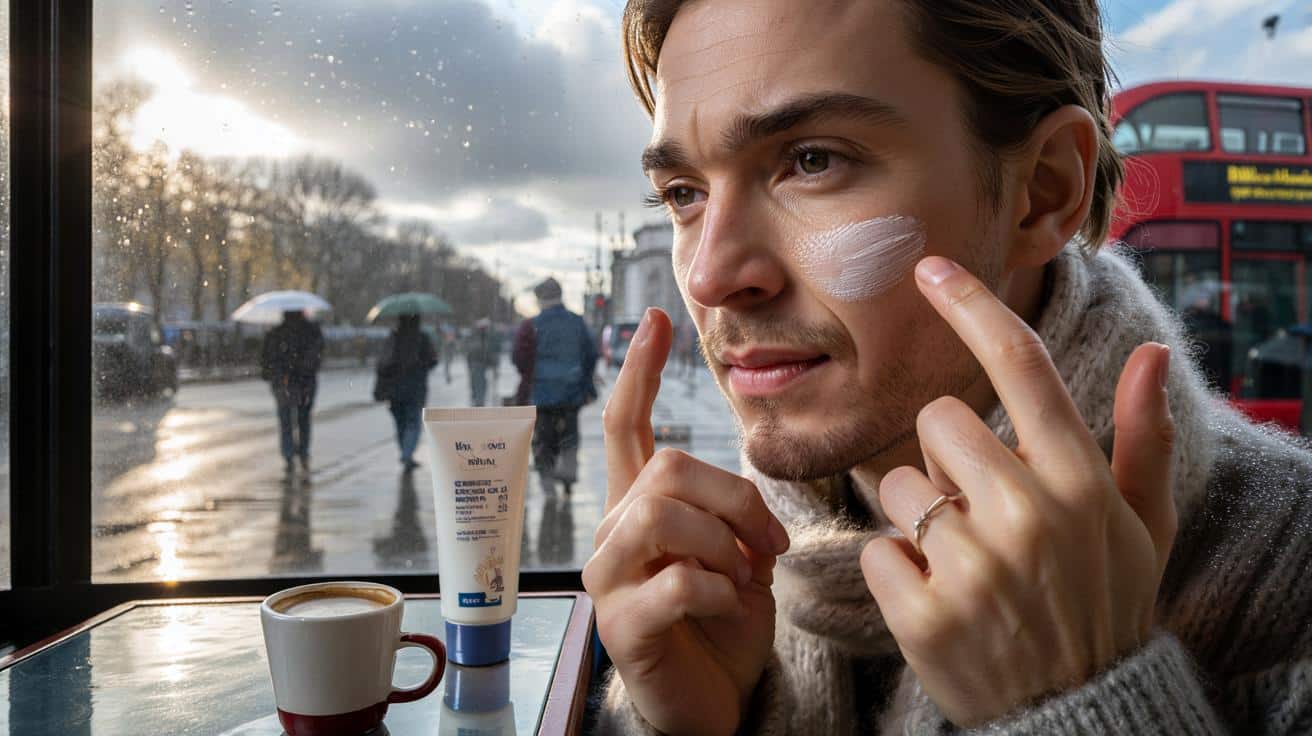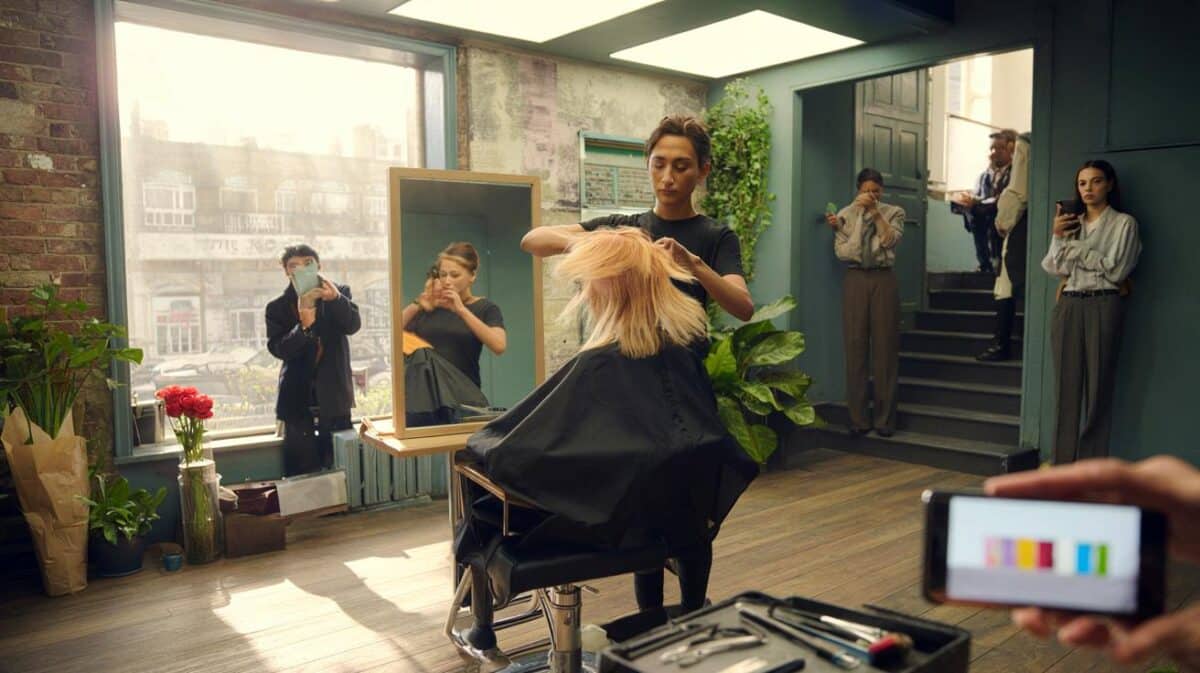It sounds sensible, almost cosy. It’s also the kind of thinking that ages our skin faster than winter ages a pear on a windowsill.
I was in a café off Bethnal Green Road, watching a man in a parka balance a flat white and a flaky croissant, when the barista asked if the sun would ever come back. People laughed. A woman beside me said she’d finally “parked the sunscreen till April”. Outside, the pavements shone with last night’s rain. A bus steamed up its own windows. Everyone looked pale, a little tired, undeniably British in November. Then a ray slipped through the cloud gap and hit a table by the window. Not warm. Still light. The kind that sneaks under our guard. The kind that doesn’t burn but quietly bites. The myth cracks.
November sun isn’t gone — it’s undercover
Grey skies don’t switch the sun off. They just dim the obvious bits. The rays that turn you pink in August are different from the ones that thread through glass and clouds in November. That soft daylight you love for reading is the same light that deepens pigment and breaks down collagen over time. Inside, outside, the glow is there. On the train. At your desk. In the car queue that never ends.
Think of the famous truck driver photo: one side of his face, the window side, etched with more lines than the other. It’s a grim little PSA about UVA — the long-wave rays that sail through clouds and most window glass. Around 95% of the UV that reaches us is UVA, and it shows far less seasonal drama than UVB. The UV index can read 1 in Manchester and still deliver a daily nudge to your pigment cells. A low hum, not a blare. But hums can turn into habits on your skin.
Here’s the logic your moisturiser won’t tell you. UVB burns and spikes in summer. UVA ages and whispers all year. UVA penetrates deeper, tangles with collagen, stirs up uneven tone and can play a role in DNA damage over time. Cloud cover blunts UVB more than it blunts UVA. Glass blocks most UVB, but not most UVA. Add bright wet pavements that bounce light upwards and you’ve got stealth radiation coming from angles you don’t expect. November doesn’t erase risk; it changes the costume.
How to wear SPF in late autumn without hating it
Keep it boring and specific: a broad-spectrum SPF 30 as your daytime finish. If your skin runs dry, moisturiser first, then SPF. Oily? Go straight in with a gel or milk SPF. Use the two-finger method for face and neck, or roughly a quarter-teaspoon. Don’t forget ears, eyelids, the hairline by the parting, and that notch at the back of the neck if your hair’s up. If you commute in daylight, that’s your moment.
We’ve all had that moment where you glance at the sky and think, “Not today.” That’s the trap. The bigger trap is using a tinted moisturiser with SPF 15 and a pea-sized dot. Quantity matters more than you think. Reapplication can be simple: a cushion compact with SPF for a quick top-up, or a fine mist if you’re not wearing base. Let’s be honest: nobody really does that every day. So load the first layer properly. Your morning layer is your safety net.
Labels help. In the UK and EU, look for the UVA circle logo, or a PA rating of +++ or higher. Zinc oxide or modern filters like Tinosorb and Uvinul cover the long waves nicely. Fragrance-free if your skin sulks in cold wind. If you’re parked by a window for hours, treat it like sun, even if you keep your coat on.
“Winter doesn’t cancel UVA. It only makes it easier to forget,” says Dr Priya Mehra, a consultant dermatologist in London. “Daily SPF 30 is a simple hedge against pigment rebound and collagen loss — the things people notice in the mirror first.”
- Choose: Broad-spectrum SPF 30 with a UVA circle or PA+++ minimum.
- Use: Two fingers for face and neck; add a third for ears and chest if exposed.
- Top-up: Cushion SPF or mist for desk days; stick sunscreen for school runs.
- Texture hacks: Gel for oily, milk or cream for dry, hybrid for makeup days.
- Windows count: Car, office, kitchen — glass isn’t a forcefield.
The bigger picture: SPF as a kindness to your future self
Skincare gets noisy. Serums multiply, promises puff up like soufflés, and we end up chasing glow in circles. SPF in November feels unglamorous beside a new retinoid or a berry-toned lipstick. Yet this is the small, repeatable act that keeps your other efforts from leaking away. Not dramatic. Useful. The kind of habit that doesn’t show off — and then one spring, your reflection does.
Think about your day in slices of light. Dog walks at 8am. A window seat at work. The sun that sits low on your commute and slips under your cap. That’s when SPF earns its keep. No lecturing, no gold stars. Just a buffer so your pigment doesn’t yo-yo, your crow’s feet don’t hurry, your cheeks keep their bounce a season longer. A rainy commute is still a UV commute. The big skincare lie says November is neutral. Your skin knows better.
| Point clé | Détail | Intérêt pour le lecteur |
|---|---|---|
| UVA is year-round | Long-wave rays penetrate clouds and most glass, with less seasonal drop | Explains why SPF matters even on grey days and at your desk |
| SPF 30, used right | Broad-spectrum, two-finger amount, hit ears/eyelids/hairline | Simple, repeatable steps that actually protect in daily life |
| Smart top-ups | Cushion, mist or stick for quick reapplication on busy days | Real-world tactics you’ll actually use, without wrecking makeup |
FAQ :
- Do I really need sunscreen in November in the UK?Yes. UVA — the photoageing ray — stays active under cloud and through windows. You won’t burn like July, but your pigment and collagen still respond to daily light.
- Will SPF block my vitamin D in winter?Short daylight, latitude and time indoors drive the winter dip more than sunscreen does. Consider diet or supplements if advised, and keep SPF for exposed skin in daytime.
- Is SPF 15 enough when the UV index is low?SPF 15 offers some protection, but SPF 30 gives a more reliable buffer, especially with real-world application habits and that stubborn UVA presence.
- Do I need to reapply if I sit by a window all day?For long window exposure, a midday top-up helps. If that feels unrealistic, apply a solid morning layer and add a cushion or mist when you remember.
- Can I use last summer’s sunscreen?If it’s been open over a year, or smells/looks off, replace it. Keep bottles out of heat and light, and treat SPF like fresh milk, not a family heirloom.








